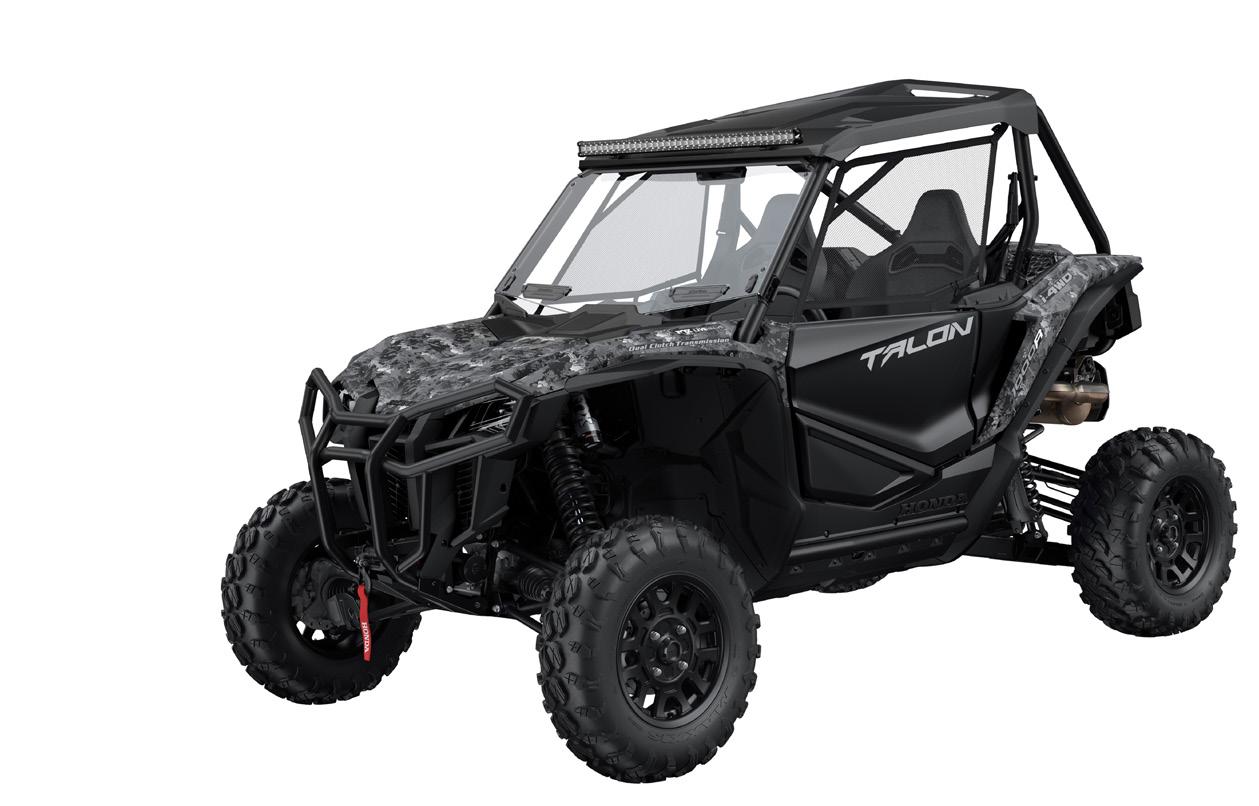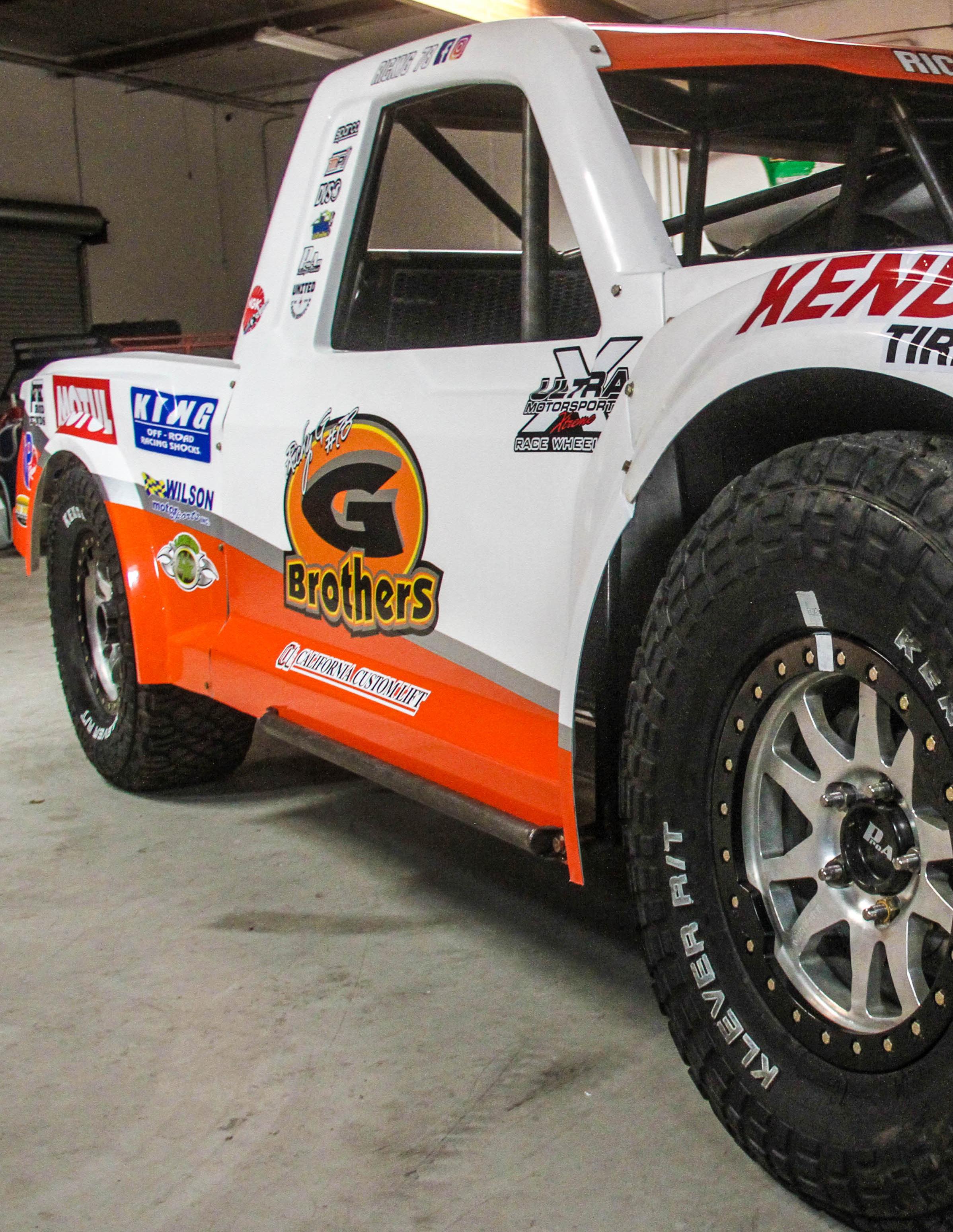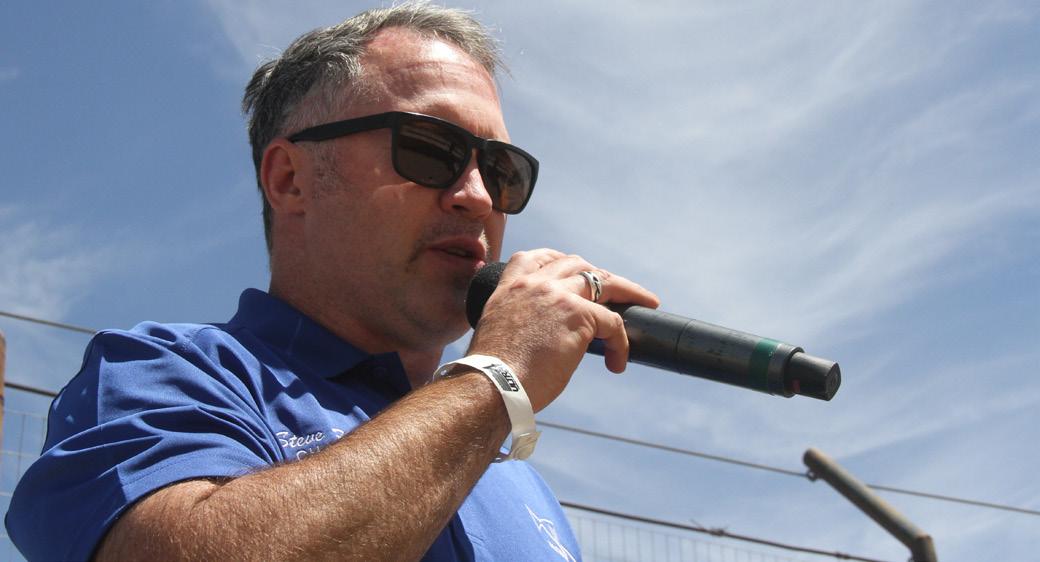
13 minute read
COVER STORY: NORRA RETURNS TO BAJA
NORRA RETURNS TO BAJA

Advertisement
Story By: La-Chelle Halliday Photos By: Shaun Ochsner, La-Chelle Halliday
Sunlight filtered through the palm trees as a coastal breeze wandered into the rolling hills that encase the legendary Rancho San Juanito, or better known today as Horsepower Ranch. Originally an oasis resort catering to Hollywood and wealthy Mexican crowd during the 60’s and 70’s, spending weekends lounging poolside, singing along with the piano player before carousing in nearby Ensenada. After sitting dormant for two decades following an ownership exchange, Horsepower Ranch emerged with a new identity succeeding full restoration to its former glory. Today the Ranch, with its vast beauty encompassing the grounds, alluring travelers and racers alike, firmly planted roots into the racing community by continuously hosting pre-race parties for the historic NORRA 1000 and the grueling SCORE Baja 1000.
Early documentation is hard to come by however, the first records indicate 1962 as the first motorcyclist to race from Tijuana to La Paz before the fascination grew exponentially over the next few years. A blitz advertising and publicity campaign from Chevrolet in the closing months of 1962, after a small fleet of specialty built trucks by Bill Stroppe finished intact in La Paz. The slogan “The Roughest Run Under the Sun” and resultant publicity, gave Baja instant fame, creating a challenge worldwide.
COVER STORY The coming years saw legends in the making, iconic builds, designs never seen before as curiosity overflowed in every backyard shop around the world. In April 1967, Bruce Meyers, creator of the infamous Meyers Manx glass bodied dune buggy, set out to test a theory of a faster route to La Paz. After 34 hours and 45 minutes, they discovered that it was indeed quicker, as they established the first record for a four wheeled vehicle. Private individuals, as well as major automotive companies were now trying the Baja.
“I knew there was a challenge down there. There was a mystique growing amongst the off-roaders about Baja. I was determined to do something about organizing it into a race of some kind.” - Ed Pearlman Tijuana to La Paz, was born with the first designated race day on October 31, 1967.

The National Off-Road Racing Association, formed by Ed Pearlman, NORRA as it would become known across the world, would become the official record keeper of Baja with full cooperation of the Mexican government. As Mexican officials were looking ahead to a boom in tourism, NORRA began to plan a major event open to any vehicle that wanted to try to race from Tijuana to La Paz. The Mexican 1000 off road race, named for the 1000 miles from Pearlman and NORRA ran the Baja races until 1973 when SCORE took over all races previously run by NORRA to include the Mexican 1000 that would later become better known as the Baja 1000 and the more affordable Baja 500.
For many years, the NORRA organization sat idle on a garage shelf until 2009 when Mike Pearlman, son of the late Ed Pearlman, decided to dust off the long-forgotten family legacy. Since its reintegration, NORRA has been the guiding light in the opening of new offroad form of motorsport, vintage Baja desert racing. For over a decade, race teams and drivers young and old have been digging up and restoring vintage machinery gearing up for the four-day, 1000mile odyssey, veterans refer to as “The Happiest Race on Earth.”
“The multiple day, rally-style format makes the trip down Baja a more scenic adventure, not a dangerous straight run. There are social gatherings at every stop, and our finish-line parties are the best in motorsports. It’s all about the fun.” - Mike Pearlman

This year had various alterations due to the worldwide pandemic including the wearing of masks, social distancing, temperature checks and onsite COVID testing. After strenuous discussions with southern cities who could not facilitate the race due to concerns of the health and safety of its inhabitants during the health crisis, the typical point to point race was altered. This alteration changed the race into a loop styled course starting and ending at Horsepower Ranch.
After the postponement and later cancellation of the 2020 Mexican 1000 last year, many teams were thankful NORRA was able to organize the journey down to Baja while adhering to local and worldwide safety precautions to ensure the health and safety of everyone. Changes were made to refuse admittance to spectators at contingency, tech inspection and to the start and finish lines.
DAY THREE / RALLY DAY ONE
Santo Tomas to San Felipe – 181.90 mi. Day one in the dirt began with a wave from the green flag underneath the NORRA arch in Santo Tomas as all teams were planning their routes through, San Vicente, La Calentura, Mike’s Sky Ranch, and El Diablo dry lakebed. The course consisted of tight and technical sections through the mountains. Every team would then finish the day at El Dorado Ranch in San Felipe along the warm waters of the Sea of Cortez after being greeted with food and drinks at the Volcon finish line celebration. Similar to any other race, a handful of problems plagued the vintage classes traveling the 181.90 miles to the end of day checkpoint. Reid Rutherford assumed he lost an alternator causing his truck to stall 12 miles from the finish but found a broken wire similar to Richard Bartell whose Vintage 6 cyl Ford Ranger broke a wire to the coil only 1 mile from the finish. Dennis Hollenbeck’s Vintage


DAY ONE & TWO
Horsepower Ranch During the first two days, Horsepower Ranch was overrun by race vehicles, filling the area with the robust sound of race vehicles, cheerful conversations between friends old and new and the lingering feeling of happiness. “The Happiest Race on Earth” was underway with the celebration just beginning at the Rigid Welcome Fiesta.

COVER STORY Class 11 VW Sedan suffered a rare failure when his fan came apart but was able to fix the fan to make it into San Felipe to fight another day. The bikes were running their own course with all lead positions held by older experienced riders. After a few cold beers, and a few tall tales over lunch, those who had no problems were free to enjoy San Felipe.
DAY FOUR / RALLY DAY TWO
San Felipe to Bahia De Los Angeles – 243.80 mi. Day two of racing consisted of faster sections to include deep sand, whoops and terrain NORRA has never explored before. With the closure of Baja California Sur, NORRA Race director Eliseo Garcia saw an opportunity to explore new terrain where the Mexican 1000 does not usually go providing new challenges, touching both coasts and heading south of Bay of LA. Majority of the teams that were out due to mechanical issues succumbing to silt, sand and rocks, were all seasoned Baja racers. Seasoned racer and heir to Parnelli Jones, son PJ Jones dawned his Can AM X3 in “Big Oly” livery to honor his father, Bill Stroppe, and Dick Russell. The Can AM X3 was draped in OG gold color looked as great today, as it did in the 1960’s. After blowing up a fan in the first stage, Dennis Hollenbeck’s Vintage Class 11 stock VW Sedan was lying in a pile of broken parts in the dirt, yet the team persevered and continued on. Wiley Davis driving his Ford Ranger, had bent the driver side spindle and smoked the bearings. Thankfully another team had the assembly necessary, and they began repairs in the parking lot in the Bay of LA with winds at 60mph attempting to interfere.


DAY FIVE / RALLY DAY THREE
Bahia De Los Angeles Loop – 257.20 mi. Baja is captivatingly beautiful and exotic, however, she devours celebrities and offroad icons alike, leaving no one untouched by her bite. This section of fast graded roads and unmaintained rocky trails left many suffering her wrath with multiple eaten up tires. The first stage out of Bahia De Los Angeles heading west towards the Pacific covered 167 miles before the stage ended in Villa Jesus Maria, 13.3 miles of transit to La Trinidad. Second stage brought teams from La Trinidad 63.60 miles to Agua De Higuera before turning back to Bahia De Los Angeles for a final 13.3 miles for the day.



DAY SIX / RALLY DAY FOUR
Bahia De Los Angeles to San Felipe – 246.80 mi. The race had been tough up to the morning of our departures out of Bay of LA, however they quickly became troublesome as uncertainty lingered when a previously dry lakebed had been flooded. Officials quickly routed all teams and racers through a change of course adding to the challenges of navigating the race. Unlike other Baja races, the Mexican 1000 has no markings on the course, ensuring the difficulty is felt evenly throughout all classes. By this day, some competitors have fallen, whilst some dodged a bullet. Reid Rutherford’s Trophy Lite ended up rolling while transitioning from dirt to pavement. With a quick assessment and assistance from the Palapa Boy Racing chase team, the Trophy Lite was back on all four wheels showcasing a stylish duct tape repair job as they trudged on to cross the finish line. Dave Moore, driving his Vintage 4x4 Ford Bronco hit a large rock hard enough to sheer four bolts off the left read beadlock, somehow without causing the tire to flatten. DAY SEVEN / RALLY DAY FIVE San Felipe to Horsepower Ranch – 211.30 mi. The final leg to the rally encompassed miles of rough and technical terrain out of San Felipe, then pacing 46 miles to begin their sprint through Diablo dry lakebed. After transitioning to the highway all racers headed towards the entrance of Mike’s Sky Rancho, aligning with special stage number two over to Piedras Gordas. After the special transit, there were only 8 miles left standing between competitors and capturing a win. Wiley Davis in his Ford Ranger crossed the finish line, holding a firstplace class position but only after going through 3 tires, a wheel, a broken driveshaft, hitting a tree, a shattered windshield they kicked out themselves, and ultimately, the motor failing. The Mexican 1000 five-day rally through the back country of Baja California is a one-of-a-kind experience housing a vast plethora of classic iconic chassis, driven by legendary icons hailing from all styles of motorsports. The slower paced odyssey grants the scenic route, allowing teams down time to rest, socialize, and fix ailments before the following days jaunt. Friendships are forged as teams assist one another helping change tires, patchwork from a roll over, or simply cheering each other on as they cross the daily finish line. The 2021 NORRA Mexican 1000 was one for the books with a change in course adding in brand new terrain, yet still providing the best and happiest atmosphere for all racers.

Get on the GAS!

Great American Shortcourse hosts inaugural race at Victorville Fairgrounds
Story and Photos: Shaun Ochsner
The Great American Shortcourse Series (GAS) was formed after Lucas Oil Off Road Racing shut down operations in November. Former Lucas Regional series director Lee Perfect and Ultra4 racing promoter Dave Cole saw a need to continue short course off-road racing on the west coast.
The inaugural event was held at Victorville Fairgrounds in the high desert of Southern California. Perfect has used the venue in the past for regional races during his time at Lucas Oil, so the existing dirt already had jumps and rhythm sections built in. The facility also has existing grandstands which helped to keep costs to a minimum. Fans were allowed to buy tickets
ABOVE: Lee and Poppy Perfect received a custom trophy from Louie Toszer Designs for their efforts in helping to save short course off-road racing on the west coast.



and watch the races, which is something that hasn’t been allowed since the start of COVID in 2020.
The race-day line-up had a hybrid regional and “big series” feel to it. Track action was packed with a whopping eighteen classes running throughout the day. The mood among the drivers was upbeat as Lee Perfect led the drivers meeting in the morning of the first day. The grandstands were nearly full of teams learning about how the event would be run. If the packed drivers meeting was an indication of how many racers were at the event, a cruise through the pits confirmed motor-homes, haulers and tents sprawled across almost every inch of the fairground’s property. There were the usual Pro-2, Pro-lite and Pro-buggy classes. Still absent was Pro-4. Sadly, there still aren’t enough of the big trucks left on the west coast to justify running them.


ABOVE: The Kart classes help groom the future stars of short-course off-road racing. G3 Argyros swept the podium in J2. LEFT: 1600 desert buggy is mixed in with the limited buggy class.

Also, on the line-up was the growing Class 11 race. More and more classic VW bugs are showing up to race, and GAS seems to be a perfect venue for them. You can always count on the Trophy Karts as well. The Kart classes are the future generation of short course off-road. As UTV’s continue their popularity growth, classes are added for them. GAS had six UTV classes. Two of those were geared towards youth.
The 2021 GAS season will include eight rounds of racing across three venues that include Victorville Fairgrounds and Glen Helen Raceway. A third venue has yet to be announced after the recent closure of Wild West Motorsports Park in Reno, Nevada.



While the series does not have a television package, races were streamed all weekend across social media and the web using a live drone and multiple fixed camera angles.

ABOVE: Dave Mason Jr. finished 2nd in Round 1 and took a win in Round 2. With two podium finishes, he has the points lead for the season.













